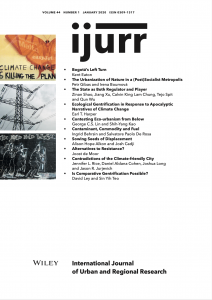As local governments and corporations promote ‘climate friendliness’, and a low‐carbon lifestyle becomes increasingly desirable, more middle‐ and upper‐income urban residents are choosing to live near public transit, on bike‐ and pedestrian‐friendly streets, and in higher‐density mixed‐use areas. This rejection of classical forms of suburbanization has, in part, increased property values in neighborhoods offering these amenities, displacing lower‐income, often non‐white, residents. Increased prevalence of creative and technology workers appears to accelerate this trend. We argue that a significant and understudied socio‐environmental contradiction also occurs where the actual environmental outcomes of neighborhood transformation may not be what we expect. New research on greenhouse gas emissions shows that more affluent residents have much larger carbon footprints because of their consumption, even when reductions in transportation or building energy emissions are included. We describe an area in Seattle, Washington, the location of Amazon’s headquarters, experiencing this contradiction and show a distinct convergence of city investments in low‐carbon infrastructure, significant rises in housing prices and decreases in lower‐income and non‐white residents. We conclude with a discussion of a range of issues that require more attention by scholars interested in housing justice and/or urban sustainability.
Details
Written by:
Jennifer L. Rice, Daniel Aldana Cohen, Joshua Long & Jason R. Jurjevich
Digital Object Identifier (DOI)
10.1111/1468-2427.12740
About DOI

